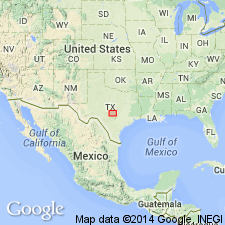
- Usage in publication:
-
- Welge sandstone member*
- Modifications:
-
- Named
- Dominant lithology:
-
- Sandstone
- AAPG geologic province:
-
- Llano uplift
Summary:
Pg. 114, pls. 1, 2, 4 (fig. 5). Welge Sandstone member of Wilberns formation. Brown mostly nonglauconitic sandstone. Average thickness 18 feet; at type locality 27 feet; thicker sections are along northern and western sides of Llano uplift. Overlies Lion Mountain sandstone here considered member of Riley formation; contact abrupt. Underlies Maroon Creek limestone member (new) of Wilberns formation; contact is gradational. [Age is Late Cambrian. Report includes cross sections.
Type section: along Squaw Creek [now Big Nixon Creek] approx. 0.5 mi north of Gillespie Co. line [approx. Lat. 30 deg. 30 min. 12 sec. N., Long. 99 deg. 04 min. 00 sec. W., Loyal Valley 7.5-min quadrangle, Mason Co., central TX]. Named from Welge land survey between Threadgill and Squaw Creeks. Extends throughout Llano uplift.
[Additional locality information from USGS historical topographic map collection TopoView, accessed on February 17, 2025). Geographic feature Squaw Creek renamed Big Nixon Creek (U.S. Board on Geographic Names, December 2022, USGS GNIS FeatureID 1369064) in accordance with the Department of the Interior's Secretarial Order 3404.]
Source: U.S. geologic names lexicon (USGS Bull. 1200, p. 4169); GNU records (USGS DDS-6; Denver GNULEX).
For more information, please contact Nancy Stamm, Geologic Names Committee Secretary.
Asterisk (*) indicates published by U.S. Geological Survey authors.
"No current usage" (†) implies that a name has been abandoned or has fallen into disuse. Former usage and, if known, replacement name given in parentheses ( ).
Slash (/) indicates name conflicts with nomenclatural guidelines (CSN, 1933; ACSN, 1961, 1970; NACSN, 1983, 2005, 2021). May be explained within brackets ([ ]).

